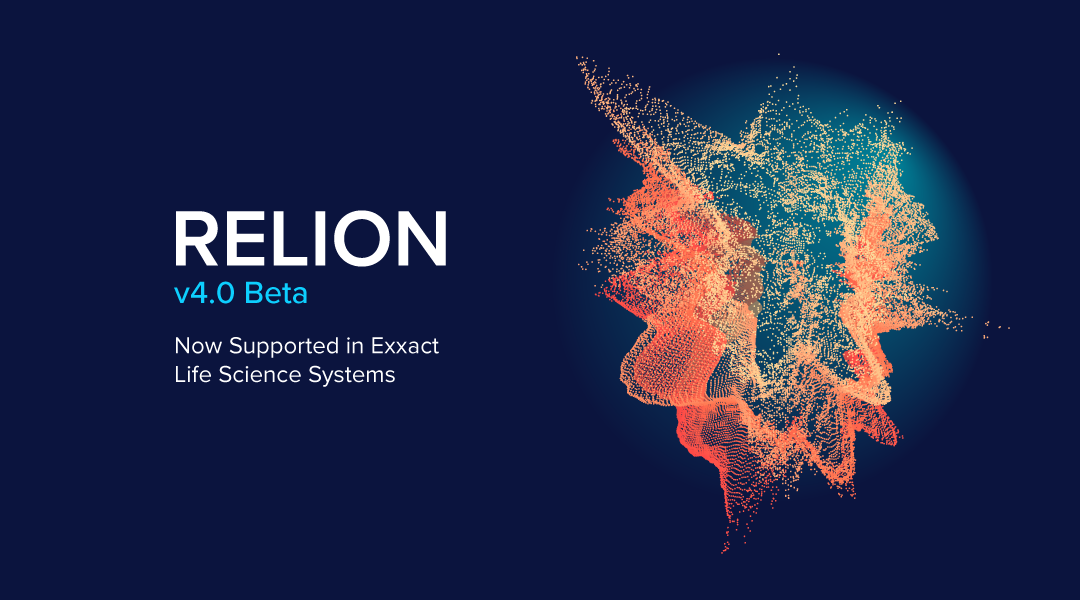
What’s new with Relion 4.0 Beta?
As a long time life science solutions provider for cryo-em applications, it was only a matter of time until we integrated the new RELION 4.0 release in our Relion for Cryo-EM Systems. Below is a brief summary of what's new. For the full documentation of the release please refer to the full release notes located at:
https://relion.readthedocs.io/en/release-4.0/index.html
A new approach to subtomogram averaging
Jasenko Zivanov and Joaquin (Kino) Oton have implemented a new approach to averaging in cryo-electron tomography, which replaces standard sub-tomograms with the concept of pseudo-sub-tomograms. The new approach leads to better weighting of the individual 2D images that make up a tilt series in relion_refine and the single-particle concepts of Bayesian polishing and CTF refinement have now also been implemented for tomography data. A preprint/publication about this work is pending.
The VDAM refinement algorithm
Dari Kimanius has implemented a new, gradient-driven algorithm with implicit regularisation, called Variable-metric Gradient Descent with Adaptive Moments (VDAM). The VDAM algorithm replaces the previously implemented SAGD algorithm for initial model generation, and makes 2D and 3D classification faster, especially for large data sets. A preprint/publication about this work, together with the automated class selection and the execution of workflow, is pending.
Automated 2D class selection
Liyi Dong developed a new algorithm for automatic selection of 2D class average images that combines features that are extracted from RELION’s 2D classification metadata with a convolutional neural network that acts on the 2D class averages themselves. The corresponding program, relion_class_ranker can be called through the Subset selection job type.
Automatic execution of workflows
Sjors developed a framework for the automated execution of predefined workflows, which is explained in more detail in the section on On-the-fly processing.
Tighter integration of the pipeliner with CCP-EM software
The CCP-EM team, mainly Matt Iadanza, Colin Palmer and Tom Burnley, have implemented a python-based pipeliner in the CCP-EM software that mimics the relion pipeliner, but will be extended to include other CCP-EM softwares too. The python interface is convenient for scripting, and can also be called from relion’s main GUI, by adding the additional argument relion --ccpem &.
Watch Sjors giving a Structural Studies Colloquium at MRC-LMB about the new features in release 4.0 on YouTube. Note that since then, Schedules have been renamed to Schemes to prevent confusion with the existing functionality to schedule jobs in the GUI.
Have any questions about RELION or other applications for molecular dynamics?
Contact Exxact Today

RELION 4.0 Beta Now Supported in Exxact Life Science Systems
What’s new with Relion 4.0 Beta?
As a long time life science solutions provider for cryo-em applications, it was only a matter of time until we integrated the new RELION 4.0 release in our Relion for Cryo-EM Systems. Below is a brief summary of what's new. For the full documentation of the release please refer to the full release notes located at:
https://relion.readthedocs.io/en/release-4.0/index.html
A new approach to subtomogram averaging
Jasenko Zivanov and Joaquin (Kino) Oton have implemented a new approach to averaging in cryo-electron tomography, which replaces standard sub-tomograms with the concept of pseudo-sub-tomograms. The new approach leads to better weighting of the individual 2D images that make up a tilt series in relion_refine and the single-particle concepts of Bayesian polishing and CTF refinement have now also been implemented for tomography data. A preprint/publication about this work is pending.
The VDAM refinement algorithm
Dari Kimanius has implemented a new, gradient-driven algorithm with implicit regularisation, called Variable-metric Gradient Descent with Adaptive Moments (VDAM). The VDAM algorithm replaces the previously implemented SAGD algorithm for initial model generation, and makes 2D and 3D classification faster, especially for large data sets. A preprint/publication about this work, together with the automated class selection and the execution of workflow, is pending.
Automated 2D class selection
Liyi Dong developed a new algorithm for automatic selection of 2D class average images that combines features that are extracted from RELION’s 2D classification metadata with a convolutional neural network that acts on the 2D class averages themselves. The corresponding program, relion_class_ranker can be called through the Subset selection job type.
Automatic execution of workflows
Sjors developed a framework for the automated execution of predefined workflows, which is explained in more detail in the section on On-the-fly processing.
Tighter integration of the pipeliner with CCP-EM software
The CCP-EM team, mainly Matt Iadanza, Colin Palmer and Tom Burnley, have implemented a python-based pipeliner in the CCP-EM software that mimics the relion pipeliner, but will be extended to include other CCP-EM softwares too. The python interface is convenient for scripting, and can also be called from relion’s main GUI, by adding the additional argument relion --ccpem &.
Watch Sjors giving a Structural Studies Colloquium at MRC-LMB about the new features in release 4.0 on YouTube. Note that since then, Schedules have been renamed to Schemes to prevent confusion with the existing functionality to schedule jobs in the GUI.
Have any questions about RELION or other applications for molecular dynamics?
Contact Exxact Today




.jpg?format=webp)